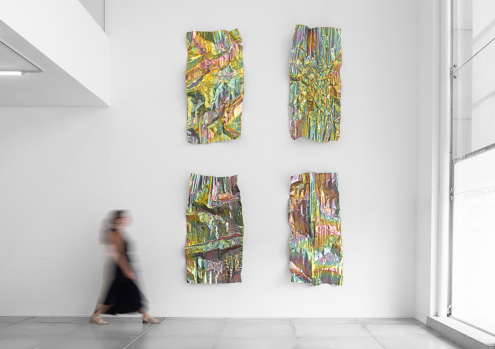Frank Ammerlaan solo show Mirror of Matter at Simões de Assis

Frank Ammerlaan solo show Mirror of Matter at Simões de Assis
Frank Ammerlaan's solo exhibition Mirror of Matter will open the 18th of March at Simões de Assis Gallery, Curitiba, Brazil.
EXHIBITION TEXT
Billions of years ago the Big Bang, an initial state of densely concentrated matter, exploded into countless galaxies, suns, stars, systems and planets. All life, all things, came from that single instant, and every atom in the Universe that was formed then continues to exist until now (and forever), as matter is only transformed, never created. The particles that make up everything, from human bodies to celestial ones, from bacteria to whales, from extinct species to fossil fuel, are the same since the beginning of time, mutating endlessly.
In Mirror of Matter, Frank Ammerlaan explores materials that are a little unusual in contemporary artistic practices, investigating the depths of the elements that conform his works by extracting their aesthetic properties above all else. This exhibition is divided into four ensembles, each revealing in different manners the artist’s interest in manipulating chemicals, metals, minerals, organic substances and more. In a process that could be described as alchemical – not necessarily for its spiritual aspect, but due to the association of the intuitive and experimental quality of the artist’s work with his equally experimental scientific approach –, Ammerlaan articulates pictorial and sculptural gestures with mediums that are usually foreign to the creative realm and more common in industries or laboratories, operating as an agent of transformation.
Upon entering the gallery, the audience will already be able to see the artist’s way of thinking translated into the first part of the show. Corrugated steel sheets are placed in the first room of the exhibition, welcoming visitors with their solar reflective surface. These sheets were not only crumpled and smashed to form volumes and reliefs, but also underwent chemical baths – which leads to the formation of a layer of zinc on their surfaces. After they are finished, they begin to oxidate over time, and to change colors and patterns. The artist collaborates with and counts on this natural process, as he employs ready-made materials typical of the construction industry, dislocates them into the studio and subjects them to chemical processes, and then lets the spontaneous physical reactions take over.
In other metallic works, the use of lead sheets could point to the creation of massive three-dimensional pieces. Nonetheless, the material is folded, creased, bent and inflated as to resemble soft cushy surfaces made of fabric. These voluminous objects are hung on the wall, playing with the sculptural and pictorial nature of this production. It is interesting to notice the physical challenge that bending and folding a material that is surprisingly malleable and flexible, while also being extremely heavy and dense, entails. The body has to wrestle the metal. But it’s not only the hand of the artist that produces these pieces: lead also changes color as the oxidation begins, turning from a shiny bluish gray to an opaque cinder shade. Nature is, again, a kind of co-author of the works.
Ammerlaan also explores a more traditional pictorial medium in paintings that evoke the multicolored patches of oil spills in the ocean. At first glance, they might appear to be the actual result of brushstrokes on a canvas, but again the artist misleads the audience as he plays with our perception – sometimes, what the works are and what they appear to be are worlds apart. These canvases are actually first coated with a primer and then undergo immersion baths with different chemicals that cause the shapes, shades and iridescence to arise. Giving up control of the final result, this method is based on trial and error, and the conditions of temperature and humidity, and the order of the chemicals used must be precise, even if we don’t know how the painting will emerge.
And yet, there is a body of works in the exhibition that is initially composed of elements that have been created by nature and then appropriated by the artist. However, their origin is unknown. The paintings are produced with meteorite particles: detritus from the cosmos that have come into earth’s atmosphere and hit its surface. Their metallic or rocky composition is extremely dense, they are often magnetic, and scientists have even discovered that fragments dating from 4.5 billion years ago may have carried water and organic matter when they fell to earth. It is rather impressive to see how these once gigantic and now tiny parts from the dawn of our universe can be turned into a painting. Opposing the violent magnitude of asteroids that could destroy life on this planet a few times over with the singular and sublime act of artistic creation is fundamental in these pieces. However, as we now know, nothing is actually being created, everything is just being transformed – be it by natural processes, or by the hands of Frank Ammerlaan.
- Julia Lima
Mirror of Matter | Frank Ammerlaan
Simões de Assis
18 March - 6 May 2023
Publication date: 16 Mar '23

